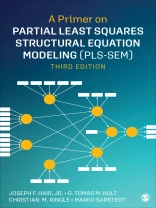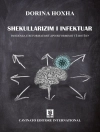The third edition of A Primer on Partial Least Squares Structural Equation Modeling (PLS-SEM) guides readers through learning and mastering the techniques of this approach in clear language. Authors Joseph H. Hair, Jr., G. Tomas M. Hult, Christian Ringle, and Marko Sarstedt use their years of conducting and teaching research to communicate the fundamentals of PLS-SEM in straightforward language to explain the details of this method, with limited emphasis on equations and symbols. A running case study on corporate reputation follows the different steps in this technique so readers can better understand the research applications. Learning objectives, review and critical thinking questions, and key terms help readers cement their knowledge. This edition has been thoroughly updated, featuring the latest version of the popular software package Smart PLS 3. New topics have been added throughout the text, including a thoroughly revised and extended chapter on mediation, recent research on the foundations of PLS-SEM, detailed descriptions of research summarizing the advantages as well as limitations of PLS-SEM, and extended coverage of advanced concepts and methods, such as out-of-sample versus in-sample prediction metrics, higher-order constructs, multigroup analysis, necessary condition analysis, and endogeneity.
Spis treści
Preface
About the Authors
Chapter 1. An Introduction to Structural Equation Modeling
Chapter Preview
What Is Structural Equation Modeling?
Considerations in Using Structural Equation Modeling
Principles of Structural Equation Modeling
PLS-SEM, CB-SEM, and Regressions Based on Sum Scores
Considerations When Applying PLS-SEM
Guidelines for Choosing Between PLS-SEM and CB-SEM
Organization of Remaining Chapters
Summary
Review Questions
Critical Thinking Questions
Key Terms
Suggested Readings
Chapter 2. Specifying the Path Model and Examining Data
Chapter Preview
Stage 1: Specifying the Structural Model
Stage 2: Specifying the Measurement Models
Stage 3: Data Collection and Examination
Case Study Illustration—Specifying the PLS-SEM Model
Summary
Review Questions
Critical Thinking Questions
Key Terms
Suggested Readings
Chapter 3. Path Model Estimation
Chapter Preview
Stage 4: Model Estimation and the PLS-SEM Algorithm
Case Study Illustration—PLS Path Model Estimation (Stage 4)
Summary
Review Questions
Critical Thinking Questions
Key Terms
Suggested Readings
Chapter 4. Assessing PLS-SEM Results—Part I: Evaluation of the Reflective Measurement Models
Chapter Preview
Overview of Stage 5: Evaluation of Measurement Models
Stage 5a: Assessing Results of Reflective Measurement Models
Case Study Illustration—Evaluation of the Reflective Measurement Models (Stage 5a)
Summary
Review Questions
Critical Thinking Questions
Key Terms
Suggested Readings
Chapter 5. Assessing PLS-SEM Results—Part II: Evaluation of the Formative Measurement Models
Chapter Preview
Stage 5b: Assessing Results of Formative Measurement Models
Case Study Illustration—Evaluation of the Formative Measurement Models (Stage 5b)
Summary
Review Questions
Critical Thinking Questions
Key Terms
Suggested Readings
Chapter 6. Assessing PLS-SEM Results—Part III: Evaluation of the Structural Model
Chapter Preview
Stage 6: Structural Model Results Evaluation
Case Study Illustration—Evaluation of the Structural Model (Stage 6)
Summary
Review Questions
Critical Thinking Questions
Key Terms
Suggested Readings
Chapter 7. Mediator and Moderator Analysis
Chapter Preview
Mediation
Moderation
Case Study Illustration—Moderation
Summary
Review Questions
Critical Thinking Questions
Key Terms
Suggested Readings
Chapter 8. Outlook on Advanced Methods
Chapter Preview
Importance-Performance Map Analysis
Necessary Condition Analysis
Higher-Order Constructs
Confirmatory Tetrad Analysis
Examining Endogeneity
Treating Observed and Unobserved Heterogeneity
Measurement Model Invariance
Consistent PLS-SEM
Summary
Review Questions
Critical Thinking Questions
Key Terms
Suggested Readings
Glossary
References
Index
O autorze
Marko Sarstedt is Professor of Marketing at the Ludwig-Maximilians-University Munich (Germany) and an adjunct research professor at Babe?-Bolyai-University Cluj-Napoca (Romania). His main research interest is the advancement of research methods to further the understanding of consumer behavior. His research has been published in Nature Human Behaviour, Journal of Marketing Research, Journal of the Academy of Marketing Science, Multivariate Behavioral Research, Organizational Research Methods, MIS Quarterly, British Journal of Mathematical and Statistical Psychology, and Psychometrika, among others. His research ranks among the most frequently cited in the social sciences with more than 100, 000 citations according to Google Scholar. Marko has won numerous best paper and citation awards, including five Emerald Citations of Excellence awards and two AMS William R. Darden Awards. Marko has been repeatedly named member of Clarivate Analytics’ Highly Cited Researchers List. In March 2022, he was awarded an honorary doctorate from Babe?-Bolyai-University Cluj-Napoca for his research achievements and contributions to international exchange.












